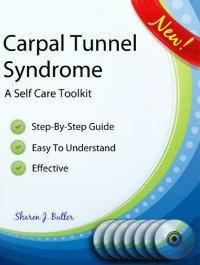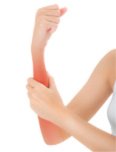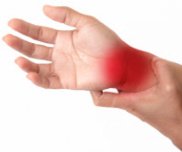Carpal Tunnel Syndrome Self Care

Click HERE to Learn More
There are a lot of home remedies for carpal tunnel syndrome that you can do on your own. Carpal Tunnel Syndrome self care requires a couple of relatively easy steps.
- Eliminate sources of constant strain: gripping, typing, squeezing
- Improve your posture
- Recognize and stop other personal movement habits that cause strain or put pressure on the median nerve
- Drink a lot of water
Stretching Is The Key To Effective Carpal Tunnel Syndrome Self Care
The most common source of strain is from adhesions, or stuck places, in the fascia that goes from the shoulders, through the armpits and down into the arms and hands. Stretching is the ultimate answer to eliminating Carpal Tunnel Syndrome. In order to enjoy the most success in your recovery program, this includes stretching:
- Neck and shoulders
- The armpits
- The biceps and triceps muscles
- The flexor muscles in the forearms
- The retinaculae surrounding the wrists (a bracelet of fascia which holds the tendons next to the wrist bones)
- The palms
- The fingers
Fully releasing all the tightness, restriction and adhesions in all these areas will significantly increase your chances of a successful and full recovery.
For information about how to do a really effective stretch, click here.
There are lots of free online resources for finding stretches that will help you with carpal tunnel symptoms. But if you are looking for expert guidance, I have designed a program that will guide you through all the steps, in their right order, with all the best stretches to help you get rid of your Carpal Tunnel Syndrome symptoms as quickly as possible. If you are interested in learning more, click here.
Improving Your Posture Is Essential In Carpal Tunnel Syndrome Self Care
Good posture is an extremely important step for the best Carpal Tunnel Syndrome self care. Proper posture places the least amount of strain on all the soft tissues of the body, particularly the fascia that surrounds the median nerve.
With Carpal Tunnel Syndrome, posture problems can make your symptoms worse very quickly. First, make sure that you do not slouch. Slouching tends to compress the entire nerve bundle that serves the arm and hand.
Evaluate your posture and make corrections when you notice slouching, reaching forward, a forward head, or any of the other markers for improper posture. If you are unable to recognize these tendencies in your own body, then a physical therapist or a therapist experienced in Structural Integration (Hellerwork, Rolfing, etc. See the “Resources” section at the bottom of the page) or the Alexander Technique can be especially helpful.
Other Ergonomic Triggers To Consider For Carpal Tunnel Syndrome Self Care
Resting Your Wrists On The Edge Of Your Desk

Any time pressure is put on the area that the median nerve passes through, the possibility grows that you will develop Carpal Tunnel Syndrome. One of the most common sources of this pressure is when you rest your forearm or wrist on the edge of a desk or work table. Even the padded wrist rests that are so common these days can put enough pressure in just the wrong place to contribute to symptoms.
The median nerve is passing right under your skin in the wrist and lower forearm so pressure there can be very irritating. Following the tips for the best sitting posture (below) will help eliminate this source of strain.
If you find that this is a common problem for you, try these tips to help correct this posture.
- Your seat may be too low. Ideally, your seat should be high enough so that when you reach forward to put your hands on a keyboard or your work surface, your elbows should be at the same level as your keyboard and your forearms should be tilted slightly downward toward your hands. This helps to discourage resting your wrists on the sharp edge of your desk. If you cannot adjust the level of your seat, try sitting on anything that will raise you up, like a seat cushion, or even some folded bath towels, books, etc.
- Your keyboard is likely too far away from your body. Here's how to find the best location for your keyboard. Sit upright with your best posture and hang your arms down at your sides. Your upper arms should be sitting alongside your torso. Bend your elbows without moving your upper arms. Now, look at where your fingertips are and that is where the keys of your keyboard should be as well. Pull your keyboard closer to your body until your fingers naturally fall onto the keys.
- Keep both feet flat on the floor. This provides your body with a stable base and reduces the possibility of your muscles having to contract to keep your body upright.
Do You Irritate The Carpal Tunnel While Sleeping?
Do you wake up with numb hands? This often occurs because you unconsciously bend your wrists palmward while you sleep, sort of like curling your hands under. This puts constant and very irritating pressure on the median nerve as it passes through the carpal tunnel at your wrist.
Fortunately, there is a really simple fix if you find this is a habit of yours. All you have to do is purchase some non-stretchy bandage tape. Cut a piece that is about 8 inches long and stick it to the back of your hand and wrist so that it crosses from the back of your hand, over the wrist and onto the forearm. When you are sleeping, you will feel a slight tug on your skin if you begin to bend your wrist. The tape will help stabilize your wrist and keep it from bending.
Your Water Intake and Carpal Tunnel Syndrome
Tissues that are properly hydrated can help reduce the irritation that goes along with the numbness and tingling characteristic of Carpal Tunnel Syndrome. Simply drinking enough water can go a long way to correcting this chronic source of unnecessary strain.
The Median Nerve which is responsible for most Carpal Tunnel Syndrome symptoms travels through the wrist bones surrounded by a sheath of fascia which is filled with synovial fluid. This fluid, made up mostly of water, is the slippery environment that helps keep the median nerve from getting irritated as it passes through the narrow, bony channel of the wrist. When you do not drink enough water, this synovial fluid becomes more sticky and less slippery and can ultimately lead to more painful symptoms, numbness and tingling.
What Role Do Your Unconscious Habits Play in Carpal Tunnel Syndrome?
What you do when you are not aware of it can be one of the more challenging aspects of Carpal Tunnel Syndrome self care. Unconscious habits that create added strain in the hands and wrists must be recognized and eliminated if at all possible. Some of the most common offenders include:
- Grasping objects too tightly which creates significant strain in the flexor muscles on the palm side of the forearm
- Keeping your arms down at your sides for extended periods of time which leads to restriction, congestion and adhesions of the tissues that pass through the armpits
- Gripping objects while the arms are extended forward of the body which tightens the tissue all the way from the fingertips to the top of the shoulders
If any of these habits are normal for you, experiment around with making some changes. For example, loosen your grip on instruments, pens, the steering wheel of your car, tools in your work, etc. to see if you can still control them but without all the squeezing.
If you find you have your arms down at your sides for most of the day, why not do some exercises, or dancing, or yoga that will get your arms overhead periodically?

When you reach forward while gripping objects or tools, you combine the strain of holding up the weight of your arms PLUS squeezing which are two powerful irritants to the carpal tunnel. A great way to eliminate this dual source of strain is to do the Reverse Stretch. Add it to your daily routine.
If a person suffering from Carpal Tunnel Syndrome only addresses the symptoms and their causes at the wrist, they stand a great chance of missing the true source of their pain which could be lurking in your unconscious habits. If you stretch the fascia along the entire pathway of the median nerve, and you correct as many of the other sources of stress to the tissues as you possibly can, you will enjoy the greatest degree of symptom relief possible.
To learn more about Carpal Tunnel Syndrome, visit the following sections:
Carpal Tunnel Syndrome Anatomy
Carpal Tunnel Syndrome Symptoms
Want To Recover Faster?
Sometimes, the most reassuring thing is having an expert who can guide you in the recovery process, telling you what to do and when to do it for the best results. For just that reason, I have developed a self care program that gives you all the steps, including the best and most effective stretches, in the right order, plus all the necessary supporting information and techniques to help you successfully recover from Carpal Tunnel Syndrome as quickly as possible. Click here for more information.
Click the block below that most closely matches your injury for more information and to find the Toolkit we offer to help you in your recovery.







